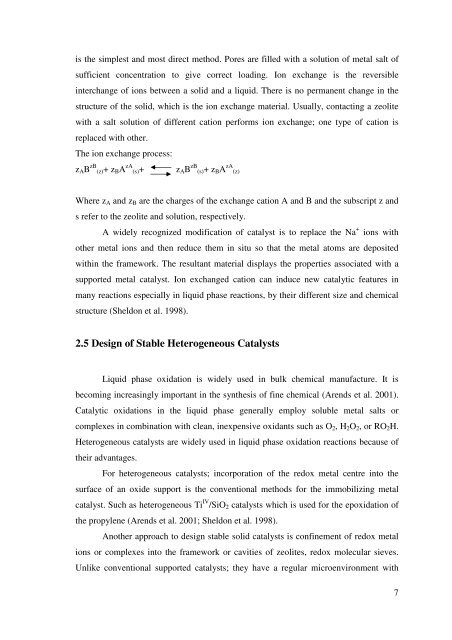the production of thymoquinone from thymol and carvacrol
the production of thymoquinone from thymol and carvacrol
the production of thymoquinone from thymol and carvacrol
Create successful ePaper yourself
Turn your PDF publications into a flip-book with our unique Google optimized e-Paper software.
is <strong>the</strong> simplest <strong>and</strong> most direct method. Pores are filled with a solution <strong>of</strong> metal salt <strong>of</strong><br />
sufficient concentration to give correct loading. Ion exchange is <strong>the</strong> reversible<br />
interchange <strong>of</strong> ions between a solid <strong>and</strong> a liquid. There is no permanent change in <strong>the</strong><br />
structure <strong>of</strong> <strong>the</strong> solid, which is <strong>the</strong> ion exchange material. Usually, contacting a zeolite<br />
with a salt solution <strong>of</strong> different cation performs ion exchange; one type <strong>of</strong> cation is<br />
replaced with o<strong>the</strong>r.<br />
The ion exchange process:<br />
zAB zB (z)+ zBA zA (s)+ zAB zB (s)+ zBA zA (z)<br />
Where zA <strong>and</strong> zB are <strong>the</strong> charges <strong>of</strong> <strong>the</strong> exchange cation A <strong>and</strong> B <strong>and</strong> <strong>the</strong> subscript z <strong>and</strong><br />
s refer to <strong>the</strong> zeolite <strong>and</strong> solution, respectively.<br />
A widely recognized modification <strong>of</strong> catalyst is to replace <strong>the</strong> Na + ions with<br />
o<strong>the</strong>r metal ions <strong>and</strong> <strong>the</strong>n reduce <strong>the</strong>m in situ so that <strong>the</strong> metal atoms are deposited<br />
within <strong>the</strong> framework. The resultant material displays <strong>the</strong> properties associated with a<br />
supported metal catalyst. Ion exchanged cation can induce new catalytic features in<br />
many reactions especially in liquid phase reactions, by <strong>the</strong>ir different size <strong>and</strong> chemical<br />
structure (Sheldon et al. 1998).<br />
2.5 Design <strong>of</strong> Stable Heterogeneous Catalysts<br />
Liquid phase oxidation is widely used in bulk chemical manufacture. It is<br />
becoming increasingly important in <strong>the</strong> syn<strong>the</strong>sis <strong>of</strong> fine chemical (Arends et al. 2001).<br />
Catalytic oxidations in <strong>the</strong> liquid phase generally employ soluble metal salts or<br />
complexes in combination with clean, inexpensive oxidants such as O2, H2O2, or RO2H.<br />
Heterogeneous catalysts are widely used in liquid phase oxidation reactions because <strong>of</strong><br />
<strong>the</strong>ir advantages.<br />
For heterogeneous catalysts; incorporation <strong>of</strong> <strong>the</strong> redox metal centre into <strong>the</strong><br />
surface <strong>of</strong> an oxide support is <strong>the</strong> conventional methods for <strong>the</strong> immobilizing metal<br />
catalyst. Such as heterogeneous Ti IV /SiO2 catalysts which is used for <strong>the</strong> epoxidation <strong>of</strong><br />
<strong>the</strong> propylene (Arends et al. 2001; Sheldon et al. 1998).<br />
Ano<strong>the</strong>r approach to design stable solid catalysts is confinement <strong>of</strong> redox metal<br />
ions or complexes into <strong>the</strong> framework or cavities <strong>of</strong> zeolites, redox molecular sieves.<br />
Unlike conventional supported catalysts; <strong>the</strong>y have a regular microenvironment with<br />
7
















